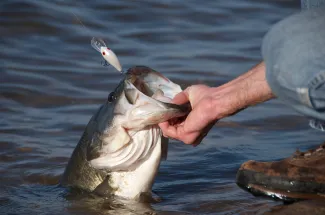
When you hear the words “trophy bass,” what comes to mind? First, I think we need to identify what constitutes a trophy largemouth. To some anglers, a bass that is half the size of the state record qualifies. To another angler, a fish one-third that size may qualify. Further, a trophy fish in one region of the country may be an average fish in another. For example, the verified state records are 17 lbs-4 oz in Florida, 14 lbs-13.7 oz in Oklahoma and 8 lbs-15 oz in Minnesota. When we look at the size distribution of these record fish we notice a decrease in size from south to north. The available growing season for largemouth bass follows a similar pattern; colder temperatures in more northern regions equate to a shorter growing season for largemouth bass.
Because of temperature differences, bass generally grow 12 months out of the year in Florida, nine months out of the year in Oklahoma and only six months out of the year in Minnesota. If a bass lived for 12 years it would be considered an old fish. Using the above growing season length, that bass will have 12 full years of growth if it is in Florida, the equivalent of nine years of growth during its lifespan in Oklahoma, and only six years of growth during its life in Minnesota. If they are growing for fewer months each year, they simply will not reach their full potential. With the goal of trophy bass, managers must realize the impact of their geographic limitation to the production size of trophy bass.
Pond size, predator abundance and available forage all play key roles. Smaller water bodies can still produce trophy fish, just fewer of them. Small ponds are also more subject to overharvest. When pursuing trophy bass we must remember that our bass must not compete with other bass for food. Crappie and green sunfish are not recommended in trophy bass ponds because they compete with bass for food resources. They also have relatively large mouths compared to other preferred forage such as bluegill and redear sunfish, which means they eat larger and more prey items. Prey items that could be going to feed and grow your trophy bass. Abundant forage and limited predator competition will produce the best results. Trophy bass managers often supplement additional forage from small satellite ponds constructed upstream from the primary pond. These ponds are stocked with a single species of forage fish and can be plumbed to drain into the primary pond through a valve, or harvested by seine and stocked in the fall. Some suggested species for satellite ponds include pre-spawn adult bluegill, fathead minnows, or crayfish.
Now, let’s take a look at the biology of a largemouth bass. Should we manage for female or male bass? Most state record bass are female, so I suggest female. Generally, male bass of the same age are smaller than females. Removing a portion, depending on pond size, of the flowing male bass annually during the spawning season will allow you to manage for female bass. This results in reduced competition on forage.
Genetics, primarily referring to Florida bass, is a topic that always comes up in discussions. A study by the Wildlife Department evaluated the Florida bass stocking program and determined a positive influence in Florida bass in the southeastern half of the state. Genetic testing did indicate that an increase in trophy fish occurred following stocking. In my 32 years of experience, I have observed an increase in the number of large bass in several of our recently reclaimed lakes approximately 10 years post renovation. These lakes are often the ones which are stocked with Florida largemouth bass. An example is Cedar Lake, where our current state record bass was caught. This may be a product of genetics, predator reduction and increased nutrient loading from inundated terrestrial vegetation when the waterbody refilled. With a high nutrient and forage to low bass ratio, managers will be limited primarily by environmental conditions for potential growth.
In the right conditions, genetics can have a potential part, but remember that time to grow, which is limited by geography, and abundant foods to eat are two main factors contributing to trophy bass.
Good luck in your pursuit of a trophy bass!